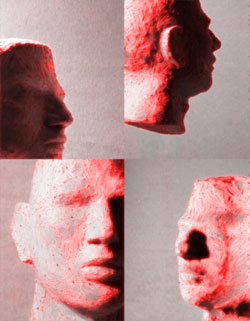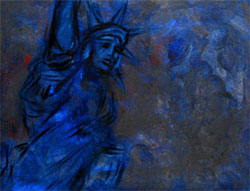|



|
"A Search For Truth And Meaning"
Andreas Jaeggi is constantly searching for beauty, harmony and balance in his art-making. But more importantly, one might add, he is searching for truth. What would be the content suggested by these generalizations – often misused and abused terms – is always a challenge for any artist to articulate much less address in their work. All the same, through Andreas Jaeggi's exhibition of work at the Berliner Kunstprojekt he takes on the task of creating a true art of exacting beauty, harmony and balance while attempting to attain his goal of presenting work which creates a feeling of "great calmness".
The way to ellicit "calmness" is not obvious. The artist's description of the exhibition, taking place during the month of June 2003, belies, it seems, the sentiment of "great calmness" expressed above. Jaeggi describes the work as "a floating graveyard of severed heads hanging from the ceiling at eye level". Will the severed heads create calm? The viewers will be the judges.
The head sculptures have evolved out of many series of figurative works created by the artist. This project on display in Berlin has developed from an earlier series of sculptural works of twenty heads as well as from a series of portraits of individuals. Though working in the long tradition of figurative sculpture, Jaeggi uses the head of a young contemporary male as his model and does not step back into the canon of art history to find a source.
All the heads in the installation are made from one mold. The repetition of the single unidentified male's head brings the work into the realm of modernist art production. Air-dryed modeling clay is enhanced with oil and acrylic paint as well as color pigment. The modernist technique of repetition is not the only cultural reference that comes to mind. Given the physicality of the disembodied heads, which remains the same from head to head to head, the genres of horror and science fiction begin to come to mind. Cloning comes to mind as easily as Marcel Duchamp's recreations of his ready-mades. Andy Warhol meets "Invasion of the Body Snatchers" meets Goya's the "Horrors of War".
In this exhibition, Jaeggi is concerned with different issues than those confronted in his series "City Impressions" or "New York Zippers". "City Impressions" for one, not only takes the form of paintings but these paintings offer gently expressionistic and stylized representations of urban landscapes. Pain and the dark side of the human condition could perhaps be devined in these works through careful study but they are certainly not readily apparent on the surface. In this recent installation, Jaeggi is concerned with the realities faced by people with grave illnesses, severe disfiguring injuries and other physical or mental disabilities. His topic extends to other groups of people marginalized by their physical condition such as the aged. Also included in the discussion are the professionals whose task it is to care for the aged and the infirm.
These works are about much more than horror. As the artist states, the heads in this exhibition are "not what would remain in the basket of the guillotine during the French Revolution". He emphasizes that in modeling the sculptures he has "kept the forceful fleshiness of a young man's head". The artist's intention is for the public to see the possibility of life in death, of strength amidst the gathering of weakness and the overall diminishing of force. Despite the confrontational nature of the work it is fundamentally optimistic. He suggests that though dying may be painful "death in and of itself is perhaps a peaceful state". Jaeggi also leaves the work open for a wide variety of interpretation and hopes for each visitor to create their own story based on the reality the work suggests to them.
Jaeggi has dramatically changed his style as his concerns have changed and his interests broadened. Early works came out of what one could call a classical tradition. Other series are related to impressionism as he interpreted street scenes and the urban landmarks of his surroundings in light of his personal aesthetic. This current work with its complex themes and difficult subject matter has directed Jaeggi towards more experimental, even avant-garde, approaches. The illustrative style of some of the street scenes, which could be as Jaeggi states "lyrical and impressionistic in the classical sense", no longer fits the current range of his subject matter.
As "City Impressions" represented street scenes in Basel, Paris and New York, "New York Zippers" was a series of 24 painted canvas flags about "The Big Apple". Closer in spirit to the current sculptural work, but still distant in terms of style, are the works of Jaeggi's "Blue Period". These atmospheric works depict nudes, still lifes and exteriors in a highly individualistic manner. The "Blue Period" works often touch on the difficulty in being human – on sorrow amidst the bloom of youth or of the dark edges of the seemingly idyllic. As with the heads, one felt Jaeggi imbuing the forms with character beyond what a simple photographic rendering of the subject matter could suggest.
Like all artists with multifarious approaches Jaeggi is less concerned with constancy than with finding the appropriate means through which to approach his current concerns. With his confrontational and forceful head sculptures Jaeggi only asks that the viewer try to keep up with him.
By Augustina O'Farrell and Erica Snow for NY Arts Magazine / Berliner Kunst
|